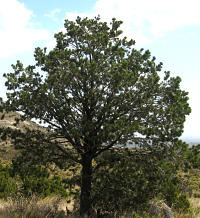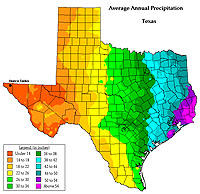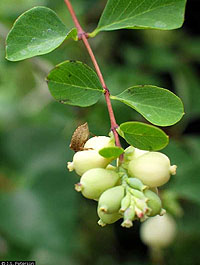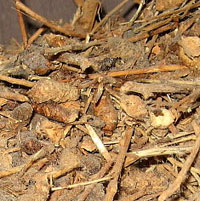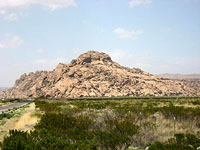Paleoclimate
Changing scene. Based on findings from pack rat middens, this artist's conception shows what Hueco Tanks may have looked like some 12,000 to 14,000 years ago (far left), some 9,300 years ago (middle) and as it appears today (right). Colorado pinyon needles found in the oldest middens imply that Hueco Tanks was cooler and wetter 14,000 years ago. By 9,000 years ago, the climate had become more arid and the pinyons disappeared, leaving a juniper-oak woodland. Today Hueco Tanks is dominated by xeric grasslands and desert scrubs. However, Arizona oak and juniper still remain in localized, sheltered sites. Images courtesy of Texas Parks and Wildlife Department. |
|
The paleoclimatic sequence of the Hueco Bolson, and Hueco Tanks in particular, has been approximated through pack rat midden analyses. The plant fossils preserved in middens from Hueco Tanks contain a history of the park's vegetation during the past 14,000 years. This history is further elucidated when compared to the regional vegetation history developed through many methods of paleoecological analysis. These include studies of cave deposits, archeological sites containing vertebrate remains, and pollen analysis of ancient sediments. These studies help to reconstruct ancient environments and climates. The basis for any pack rat midden analysis is an understanding of the contemporary flora and fauna of a site. At Hueco Tanks a survey was conducted of the plant communities now occurring in the park, and a detailed modern species list was developed (see Natural Setting for examples). Such information is used to interpret the significance of ancient plant remains preserved in the middens. Portions of at least six pack rat middens from Hueco Tanks have been analyzed. Radiocarbon analysis of the oldest one yielded a date of approximately 13,500 years before the present. A younger midden was dated to about 9,380 years ago, while several other undated middens are estimated to date from as long ago as 11,000 years to as recently as 800 to 900 years ago. Perhaps two middens are modern. Analysis of the oldest midden at Hueco Tanks revealed the presence of 29 different species of plants, 5 of which do not grow in the park today. The most significant extralocal species (not occurring at the site today) was Colorado pinyon. Today this pine is widely scattered throughout the Southwest and is known in Texas from higher elevations in the Guadalupe Mountains, the Sierra Diablo, and the Delaware Mountains. Other midden records from greater than 34,000 to about 11,000 years ago in Trans-Pecos Texas also reveal the presence of Colorado pinyon. The conclusion a paleoecologist makes, based solely on this information, is that 12,000 to 14,000 years ago this pinyon was more widespread. The questions then arise as to which factors, present several thousand years ago but not present today, provided a favorable environment in the Hueco Tanks region for Colorado pinyon pine. Several lines of evidence lead to the conclusion that the climate in this portion of the Southwest and northern Mexico was cooler, and there was probably greater rainfall and lower evaporation rates. The environment must have been sufficiently different at that time to have met the ecological requirements of Colorado pinyon. Also recovered from our oldest midden were teeth of a vole. Although the exact species is not known at present, it may be the Mexican vole which is found today at high elevations in the Sacramento Mountains of New Mexico and in the Guadalupe Mountains of Texas. The Mexican vole prefers montane grasslands in ponderosa and mixed-coniferous forests. In favorable wet years, the vole may descend into the pinyon-juniper woodlands. It could have been able to survive at Hueco Tanks 14,000 years ago when conditions there favored the development of a pinyon-juniper woodland. Analysis of remains preserved in the 9,300-year-old midden from Hueco Tanks revealed that vegetation at the site had changed from that which was present approximately 4,000 years earlier as recorded in our oldest midden. Only 13 species were recovered from this midden, with only one ecologically important extralocal species recovered —Toumey oak. Today this species occurs in favorable habitats in woodlands above the Sonoran Desert in Arizona and adjacent Mexico and is known to occur at one site in the Franklin Mountains approximately 25 miles west of Hueco Tanks State Historical Park. Toumey oak usually grows in mesic, igneous areas at elevations of approximately 5,000 feet in association with some of the same plants which occur at the tanks today. Significantly, Colorado pinyon pine was absent from the midden. Apparently, by 9,300 radiocarbon years ago, Colorado pinyon already was locally extinct at Hueco Tanks State Historical Park. Evidence from other middens in the region indicates that approximately 11,000 years ago environmental conditions were modified to the point that Colorado pinyon no longer was able to survive at low elevations in the northern Chihuahuan Desert. When the pack rat midden data from Hueco Tanks is integrated with other paleoecological data from the region, a picture of the past climate and environment of the park and its surroundings emerges. Since the Late Pleistocene, the trend in the Trans-Pecos in general has been toward higher temperatures and decreasing precipitation. Prior to 12,000 years ago the northern Chihuahuan desert was covered by pinyon-juniper-oak woodland and temperatures were milder than they are today, with cooler summers, warmer winters, and greater rainfall, most falling in the winter. The period between 12,000 and 10,800 years ago marked the beginning of a vegetation shift. Summer temperatures began to rise, a monsoon season started to develop, and more mesic species such as Colorado pinyon disappeared. By 9,400 years ago, summer temperatures had increased further and precipitation had shifted to a dominant summer monsoonal pattern. A juniper-oak woodland had developed, which persists to the present at Hueco Tanks, due to the greater moisture retention of its igneous-derived soils. Between 11,000 and 8,000 years ago a major shift toward warmer and drier conditions took place. By 8,000 years ago the woodland had retreated up the mountain slopes and was replaced by grassland, while xeric species, such as prickly pear and honey mesquite, appeared in the area. Relict populations of juniper-oak woodland exist today at Hueco Tanks, due to the greater moisture retention of its igneous-derived soils, and at high elevations in the surrounding mountains. The modern climatic regime was established by about 4,000 years ago, with fewer winter freezes and adequate summer rainfall, punctuated by more frequent droughts. At this time, ocotillo, lechuguilla, and creosotebush appeared, and the transition to an essentially modern desertscrub community at Hueco Tanks was complete by around 3,600 years ago. Other indicators provide a glimpse of past environments. Pictographs from Hueco Tanks include depictions of what appear to be bighorn sheep. Although bighorn sheep remains have been recovered from a cave in the nearby Hueco Mountains, these animals are not present in the park today. Bone recovered from a small Formative village at Hueco Tanks dating to circa 900 years ago included bison, another species extirpated from the region. This section draws largely from the article "Pack Rats: Unwitting Helpers of Archeologists" by David H. Riskind and Thomas R. Van Devender first published in Texas Parks and Wildlife magazine, March 1979 (Volume 37, No. 3, pp. 6-9). |
|
